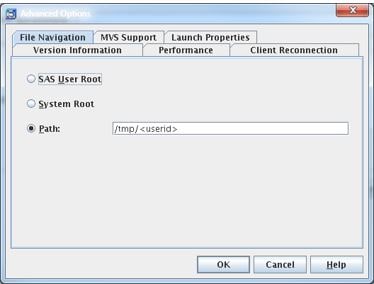Usage Note 59828: Setting the file navigation path for a workspace server
 |  |  |
To change the file navigation path for a workspace server, you need to edit the properties of the workspace server in SAS® Management Console.
Follow these steps:
- Open SAS Management Console.
- Expand the Server Manager plug-in.
- Expand your application server (for example, SASApp).
- Expand SASApp - Logical Workspace Server.
- Right-click SASApp - Workspace Server.
- Select Properties.
- Select Options ► Advanced Options.
- Select the File Navigation tab.
- Make your changes and click OK.
- Restart the SAS Object Spawner.
The File Navigation tab contains the following options:
- SAS User Root specifies that the initial directory for the SAS session should be the same as the SAS user root directory.
- System Root specifies that the initial directory for the SAS session should be the same as the system root directory.
- Specify Path specifies that the initial directory for the SAS session should be the directory that is specified in the associated field.
Use these fields to specify the initial directory for navigating the SAS session on the server. In SAS® Enterprise Guide® and SAS® Add-In for Microsoft Office, the initial directory specifies the root directory for server navigation.
User-specific directory locations can be used via the <userid> token, which resolves to the host ID for the user. For example, when logging in with sasdemo, the file navigation path below will resolve to /tmp/sasdemo.
Note: The directory /tmp/sasdemo must already exist on the file system. The sasdemo (<userid>) directory is not created automatically.

Many SAS administrators have to reference more than one path where folders or files do not exist within the same subdirectory; examples follow:
- C:\public\sasdata
- C:\users\sales
Because the File Navigation tab options can accept only a single path, create symbolic links to the directories in question.
For the above example, create symbolic links to both sasdata and sales in a single directory. Then refer to this single directory path in the Specify Path field on the File Navigation tab.
Operating System and Release Information
| Product Family | Product | System | SAS Release | |
| Reported | Fixed* | |||
| SAS System | SAS Workspace Server | z/OS | ||
| Microsoft® Windows® for 64-Bit Itanium-based Systems | ||||
| Microsoft Windows Server 2003 Datacenter 64-bit Edition | ||||
| Microsoft Windows Server 2003 Enterprise 64-bit Edition | ||||
| Microsoft Windows XP 64-bit Edition | ||||
| Microsoft® Windows® for x64 | ||||
| Microsoft Windows 8 Enterprise 32-bit | ||||
| Microsoft Windows 8 Enterprise x64 | ||||
| Microsoft Windows 8 Pro 32-bit | ||||
| Microsoft Windows 8 Pro x64 | ||||
| Microsoft Windows 8.1 Enterprise 32-bit | ||||
| Microsoft Windows 8.1 Enterprise x64 | ||||
| Microsoft Windows 8.1 Pro 32-bit | ||||
| Microsoft Windows 8.1 Pro x64 | ||||
| Microsoft Windows 10 | ||||
| Microsoft Windows 95/98 | ||||
| Microsoft Windows 2000 Advanced Server | ||||
| Microsoft Windows 2000 Datacenter Server | ||||
| Microsoft Windows 2000 Server | ||||
| Microsoft Windows 2000 Professional | ||||
| Microsoft Windows NT Workstation | ||||
| Microsoft Windows Server 2003 Datacenter Edition | ||||
| Microsoft Windows Server 2003 Enterprise Edition | ||||
| Microsoft Windows Server 2003 Standard Edition | ||||
| Microsoft Windows Server 2003 for x64 | ||||
| Microsoft Windows Server 2008 | ||||
| Microsoft Windows Server 2008 R2 | ||||
| Microsoft Windows Server 2008 for x64 | ||||
| Microsoft Windows Server 2012 Datacenter | ||||
| Microsoft Windows Server 2012 R2 Datacenter | ||||
| Microsoft Windows Server 2012 R2 Std | ||||
| Microsoft Windows Server 2012 Std | ||||
| Microsoft Windows XP Professional | ||||
| Windows 7 Enterprise 32 bit | ||||
| Windows 7 Enterprise x64 | ||||
| Windows 7 Home Premium 32 bit | ||||
| Windows 7 Home Premium x64 | ||||
| Windows 7 Professional 32 bit | ||||
| Windows 7 Professional x64 | ||||
| Windows 7 Ultimate 32 bit | ||||
| Windows 7 Ultimate x64 | ||||
| Windows Millennium Edition (Me) | ||||
| Windows Vista | ||||
| Windows Vista for x64 | ||||
| 64-bit Enabled AIX | ||||
| 64-bit Enabled HP-UX | ||||
| 64-bit Enabled Solaris | ||||
| HP-UX IPF | ||||
| Linux | ||||
| Linux for x64 | ||||
| Linux on Itanium | ||||
| OpenVMS Alpha | ||||
| Solaris for x64 | ||||
| Tru64 UNIX | ||||
| Type: | Usage Note |
| Priority: |
| Date Modified: | 2019-11-15 10:48:03 |
| Date Created: | 2017-01-30 13:36:07 |